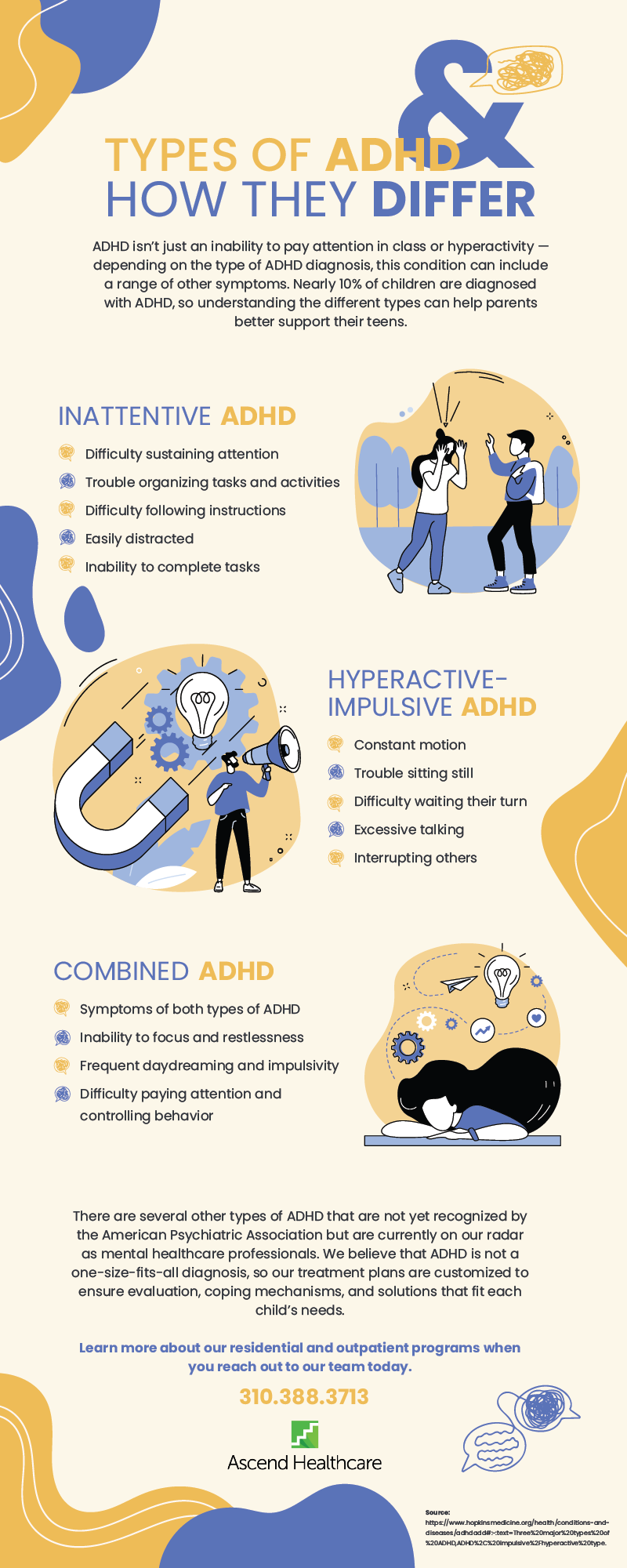Learn About ADHD in Children
As a parent, caregiver, or individual diagnosed with attention-deficit/hyperactivity disorder (ADHD), managing the condition can be complex. ADHD is a neurodevelopmental disorder that affects millions of children and adults worldwide, and it can be complicated to diagnose and manage. Even more confusing, there are several types of ADHD with different symptoms and treatment plans. Understanding the different forms of ADHD can help you figure out what you need to succeed. And if your teen is struggling, Ascend’s ADHD treatment program in California may help you find more answers.
An Overview of Attention-Deficit/Hyperactivity Disorder
ADHD is a condition that affects the prefrontal cortex of the brain, an area responsible for executive functions, such as decision-making, problem-solving, and impulse control. ADHD can be characterized by inattention, impulsivity, and hyperactivity. Individuals with the condition may have difficulty focusing, following directions, organizing tasks, and regulating emotions.
ADHD is often diagnosed in childhood and can persist into adulthood, although the symptoms may become less obvious over time. Children and teens with ADHD can benefit from structure, therapy, and medication to help manage their symptoms.
Breaking Down the Different Types of ADHD
There are three types of ADHD recognized by the National Institute of Mental Health, including inattentive, hyperactive-impulsive, and combined. Here, you’ll find an overview of all three, but there are a few other emerging types of ADHD that require more research and support, like limbic ADHD, over-focused ADHD, and anxious ADHD.
Inattentive ADHD
This form of ADHD is characterized by difficulty paying attention, being easily distracted, forgetfulness, and disorganization. It is sometimes referred to as attention deficit disorder (ADD), although this term has fallen out of use. Inattentive ADHD can be difficult to diagnose, as the symptoms may appear subtle.
Hyperactive-Impulsive ADHD
This type of ADHD is characterized by hyperactivity, impulsivity, and difficulty sitting still. Those with this this kind of attention-deficit/hyperactivity disorder may be constantly on the go, talk excessively, or struggle to wait their turn in conversations.
Combined ADHD
The most common form of ADHD is a combination of inattentive and hyperactive-impulsive symptoms. People with combined ADHD may struggle with the following:
- Difficulty focusing
- Forgetfulness
- Disorganization
- Impulsivity
- Hyperactivity
- Restlessness
Treating ADHD in Children
The diagnosis of ADHD in children can involve evaluations such as IQ tests, neuropsychological tests, and ADHD rating scales. A comprehensive evaluation can help identify which type of ADHD an individual may have and help to better tailor treatment.
ADHD is often diagnosed in childhood, and early intervention is essential to ensure that children receive the support they need to thrive. Treatment for ADHD can include medication, therapy, or both. Medications, such as stimulants or non-stimulants, can help with focus and impulse control, while behavioral therapy can help with emotional regulation and social skills training.
At Ascend, our evidence-based approach to ADHD treatment focuses on holistic care, including medication management, therapy, coaching, and mindfulness. We seek to address the individual needs of each client, ensuring that they receive customized care.
Reach Out to Ascend Today
Understanding the different types of ADHD can help you or your loved one better manage the condition. At Ascend, our team of mental health professionals is here to provide support and answers to your questions.
Reach out to Ascend today to learn more about ADHD treatment options and how we can help the journey to healing for the entire family system. Call 310.388.3713 or reach out to us online today to get started.








